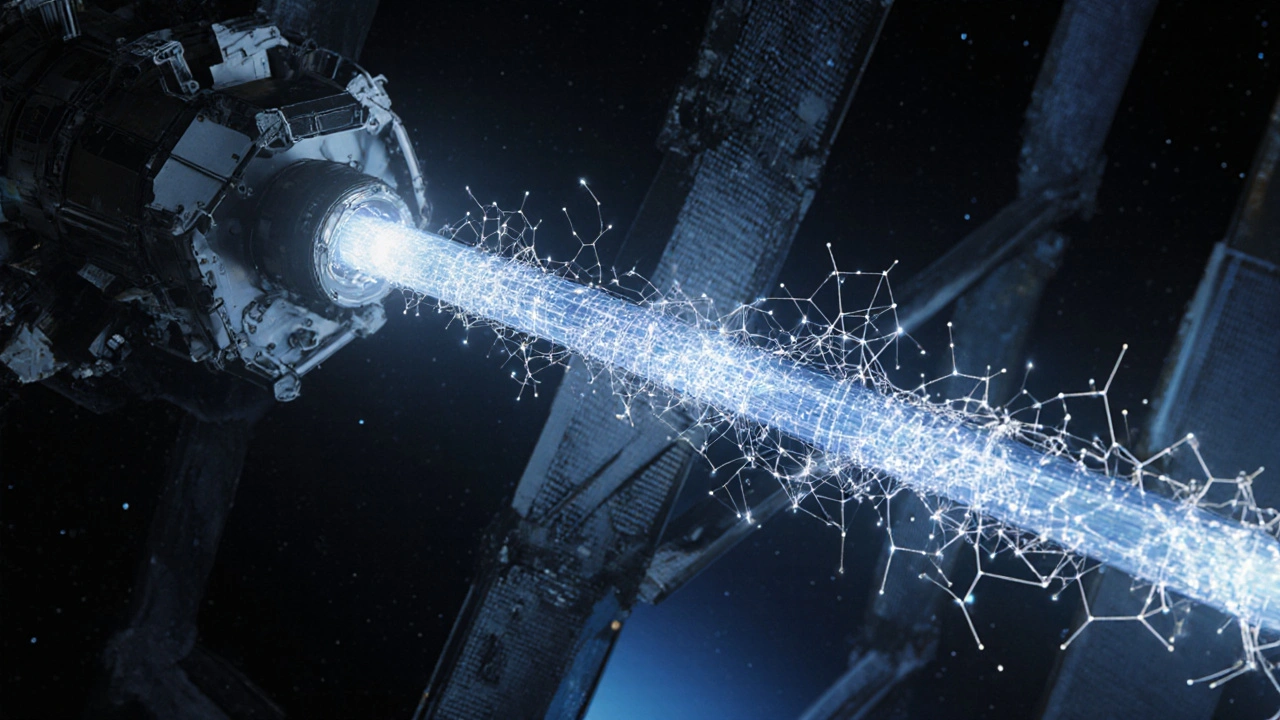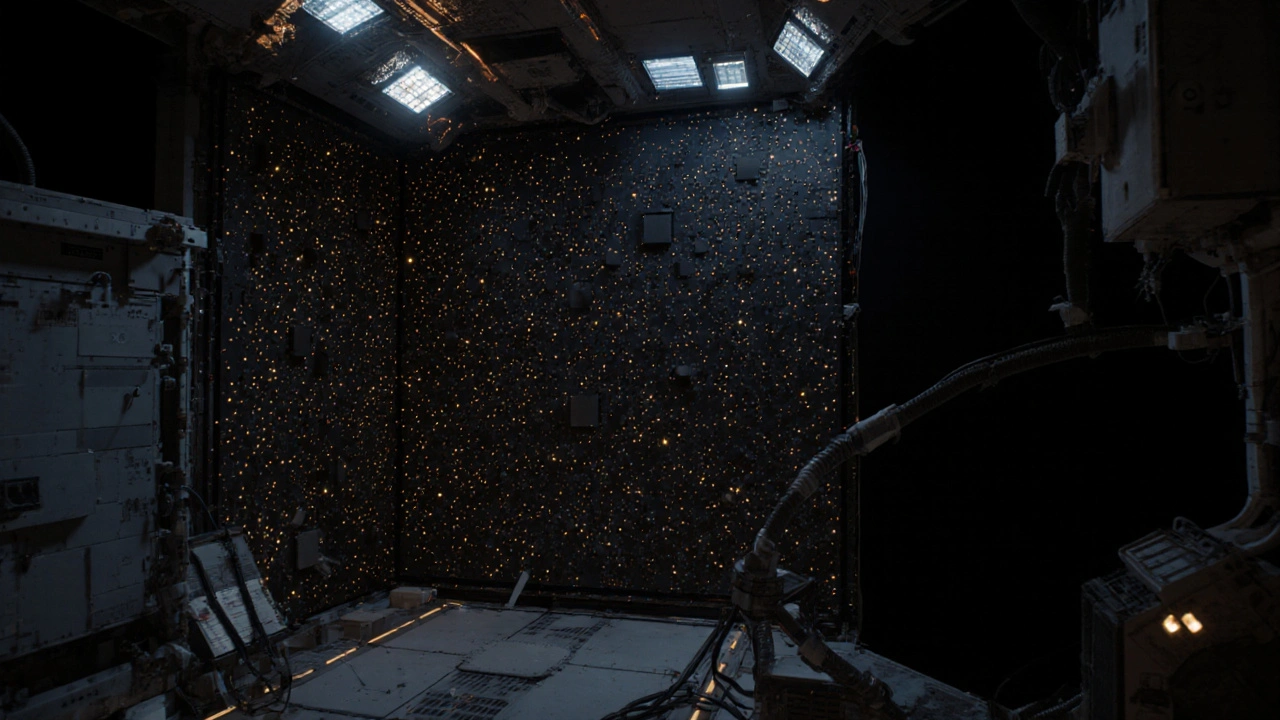When you think of a space station, you probably imagine astronauts floating in zero gravity, conducting experiments, or repairing equipment. But behind the scenes, there’s another critical job happening 24/7: structural health monitoring. Unlike a car that gets checked at a garage every few months, space stations can’t pull over for an inspection. A tiny crack in a pressure wall, a loose bolt, or a slow leak could turn into a disaster in minutes. That’s why modern stations like the International Space Station rely on real-time sensor networks to catch problems before they become emergencies.
Why Traditional Inspections Don’t Work in Space
Before structural health monitoring (SHM), maintenance relied on Non-Destructive Evaluation (NDE)-periodic checks by astronauts using handheld tools. These inspections were time-consuming, risky, and often missed early signs of damage. On the ISS, astronauts have less than 4 hours a day for maintenance tasks. Waiting for someone to visually inspect every panel or listen for unusual sounds isn’t practical. That’s where SHM changes the game.
SHM doesn’t wait for problems to appear. It watches constantly. Sensors glued to critical areas-like module walls, joints, and load-bearing frames-listen for vibrations, strain, temperature shifts, and even the faintest ultrasonic noise. When something goes wrong, the system alerts ground control. No astronaut needed. No scheduled downtime. Just silent, continuous surveillance.
The Sensors That Keep Stations Alive
Not all sensors are created equal. Different parts of a station need different kinds of eyes and ears. NASA’s system on the ISS uses piezoelectric acoustic emission sensors. These aren’t always listening. They stay asleep until they detect a high-frequency event-like a crack forming or a micrometeoroid impact. When that happens, they wake up, record the signal, and send it to the ground. One system can store up to 6,000 events and run for five years on battery power. That’s not luck-it’s smart design.
But piezo sensors have limits. They’re great for sudden events, but not so good at measuring slow changes in stress or deformation. That’s where fiber optic sensing comes in. Developed at NASA’s Dryden Flight Research Center, this technology uses hair-thin optical fibers embedded into station structures. Thousands of tiny Bragg gratings are written into the fiber, each acting like a mini-sensor. As the structure bends or stretches, the light pattern changes. Engineers can map strain across entire walls with millimeter precision-all from a single fiber. It’s like giving the station a nervous system made of light.
On Earth, companies like Campbell Scientific use similar principles for bridges and buildings. Their vibrating wire sensors measure strain with 0.025 µε resolution-fine enough to detect a metal beam stretching under its own weight. What makes them stand out is VSPECT® technology, which filters out electrical noise so well that no post-processing is needed. That’s huge for remote or high-interference environments.

How Data Is Collected and Managed
Sensors are only as good as the system that reads them. Early SHM setups had long, tangled cables running from sensors to a central box. That meant more weight, more failure points, and signal degradation over distance. Modern systems solve this with distributed architecture.
Campbell Scientific’s GRANITE™ data acquisition system uses modular units placed near sensors, cutting cable lengths by up to 70%. This reduces interference and makes installation faster. On the ISS, sensors connect via certified Ethernet to ground stations, allowing engineers to monitor multiple modules simultaneously. Up to seven sensor units can be installed in one module, each sending data independently.
The real breakthrough? Time-synchronized measurements. Every sensor’s reading is timestamped to the microsecond. That lets engineers compare data across locations and identify patterns-like whether a strain spike in Module A correlates with a temperature drop in Module B. Without this sync, you’re just guessing.
Real-World Successes and Hidden Challenges
The ISS piezo system has been physically installed since 2014. But here’s the twist: it’s still waiting for astronauts to turn it on. Why? Because activation requires crew time-and crew time is the scarcest resource of all. Ground teams have tested the system thoroughly. It works. But without human intervention, it sits dormant. That’s the paradox of SHM: the most reliable systems are the ones nobody sees.
On Earth, the story’s different. Campbell Scientific’s systems have monitored bridges in Alaska, highways in Texas, and amusement park rides in Florida for over a decade. One bridge in Oregon has been under constant watch since 2008. No failures. No false alarms. Just steady, reliable data.
But SHM isn’t perfect. False positives are a headache. A sensor might pick up a tool drop, a thermal expansion, or even an astronaut bumping into a wall-and trigger an alert. Engineers spend months tuning thresholds to avoid noise. Too sensitive, and you get constant warnings. Too insensitive, and you miss a real crack.
Installation is another hurdle. NASA’s reports stress that sensor attachment is its own science. A sensor glued with the wrong adhesive, or placed at the wrong angle, won’t detect anything. That’s why training and documentation matter. Campbell Scientific’s manuals are packed with case studies. NASA’s are full of specs-but less clear on how to actually install the thing.

Where the Technology Is Headed
SHM is evolving fast. The next wave isn’t just about sensors-it’s about integration. Engineers are now linking SHM data with Building Information Modeling (BIM) and digital twins. Imagine a virtual replica of the ISS that updates in real time as sensors report strain, temperature, or vibration. Engineers can simulate how a crack might grow, predict when a component might fail, and even test repairs in the digital space before sending astronauts out.
Wireless sensors are getting smaller, cheaper, and more power-efficient. Solar-powered nodes, energy-harvesting circuits, and low-power radio protocols mean future stations could have hundreds of sensors scattered everywhere-not just on walls, but inside insulation, around joints, even inside pipes.
Machine learning is also starting to play a role. Instead of just flagging “anomaly,” systems are learning what’s normal for each section of the station. Over time, they get better at ignoring routine noise and spotting true threats. NASA’s Damage Identification and Diagnostics System (DIDS) already records signals at 1MHz. Add AI, and it could soon predict failures weeks in advance.
Who Uses This, and Why It Matters
SHM isn’t just for NASA. It’s used on offshore oil rigs, nuclear plants, and aging bridges in Europe and Asia. Any structure where failure means loss of life or billions in damage is adopting it. In the U.S., state transportation departments now require SHM on new major bridges. Insurance companies are starting to offer lower premiums for monitored infrastructure.
For space stations, it’s existential. A leak in the airlock. A crack in the solar array mount. A failed joint in the robotic arm. These aren’t theoretical risks. They’ve happened. SHM turns reactive emergency responses into proactive maintenance. It saves money, saves time, and-most importantly-saves lives.
The technology is mature enough to be trusted. The challenge now is scaling it. Making it cheaper. Making it easier to install. Making it so reliable that you don’t even need to think about it. That’s the next mission.
What is structural health monitoring (SHM) and how is it different from traditional inspections?
Structural health monitoring (SHM) uses sensors to continuously monitor the condition of a structure in real time, detecting damage like cracks, leaks, or strain as it happens. Traditional inspections, or Non-Destructive Evaluation (NDE), rely on periodic manual checks by technicians or astronauts. SHM is always on; NDE only happens when someone has time to look. For places like space stations where human access is limited, SHM is the only practical way to catch problems early.
What types of sensors are used to monitor station systems?
The most common sensors include piezoelectric acoustic emission sensors (for detecting impacts and cracks), fiber optic sensors with Bragg gratings (for measuring strain across large areas), vibrating wire sensors (for precise strain readings in noisy environments), accelerometers (for vibration analysis), and temperature sensors. NASA uses piezo and fiber optic sensors on the ISS, while terrestrial systems like those from Campbell Scientific often use vibrating wire and LVDT sensors for bridges and buildings.
How long do SHM sensors last on a space station?
NASA’s Damage Identification and Diagnostics System (DIDS) sensors are designed to operate for up to five years on battery power. This is achieved by keeping sensors in sleep mode until they detect an event, which reduces power use dramatically. Fiber optic sensors don’t need batteries at all-they’re passive and powered by light signals sent from a central unit. This makes them ideal for long-term, maintenance-free monitoring.
Can SHM systems detect leaks on space stations?
Yes. Acoustic emission sensors can detect the ultrasonic noise generated by small gas leaks. NASA’s ISS system is calibrated to pick up these high-frequency signals, even at very low flow rates. The sensors don’t identify the gas type, but they can pinpoint the location and severity of the leak by analyzing the signal pattern and timing across multiple sensors. This allows ground teams to respond before pressure drops to dangerous levels.
Why hasn’t SHM been fully activated on the ISS yet?
The hardware was installed in 2014, but activation requires astronaut time-which is extremely limited. Crews prioritize life-support tasks, science experiments, and emergency drills. Activating and validating the SHM system involves running diagnostic tests, calibrating sensors, and confirming data flow-all of which take hours. Until crew schedules allow it, the system remains in standby mode, ready but not yet active.
Is SHM used only in space, or is it common on Earth too?
SHM is widely used on Earth, especially on critical infrastructure. Companies like Campbell Scientific have been monitoring bridges, highways, dams, and tall buildings since the 1970s. In fact, many U.S. states now require SHM on new major bridges. Space applications pushed the technology forward with extreme requirements, but the real volume of deployments is on the ground-where aging infrastructure demands constant oversight.

